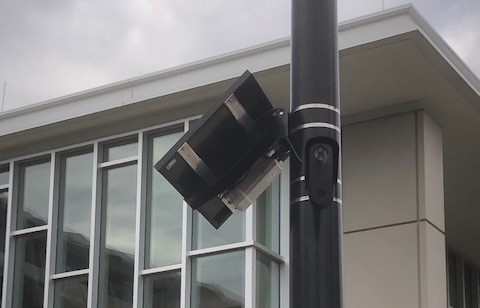Champaign Police say automated license plate readers are a tool to aid officers’ investigations

This license plate reader was installed on Green Street near Lincoln Avenue. The city of Champaign has a separate license plate reader program than the University. University of Illinois Police
Nearly four months ago, Champaign officials began installing cameras around town to take pictures of license plates on passing cars.
As of mid-September, 28 of the department’s 46 license plate readers had been positioned on Champaign streets, said Kevin Olmstead, Champaign police’s interim deputy chief of operations.
As a result, the department has logged between 25 and 30 successful resolutions to incidents while using plate readers during the investigation process, he said.
“It gives us basically another set of eyes in the area,” Olmstead said. “It's sort of a witness that we can go to and look at for information as far as the vehicles that are going through an area at a particular time that a crime occurs.”
The Champaign City Council approved the installation of automated license plate readers last December for a two-year trial.

Kevin Olmstead is Champaign's Interim Deputy Chief of Operations.
Photo Credit: City of Champaign, IllinoisThe plate readers take photos of passing vehicles and then gather data from the images, such as license plate information and vehicle characteristics – like color, make and body style.
He described the plate readers as tools that the department uses for a variety of investigations that it’s deemed “appropriate.” He said the plate readers have helped officers recover nine stolen vehicles.
“Officers have increasingly been using them for crimes such as robberies, burglaries, vehicle thefts,” Olmstead said. “They've been in very well use for those.”
The Champaign City Council initially agreed to put forth approximately $237,000 over the course of two years to fund the trial, but Olmstead said the city hasn’t paid any of that amount because the contract doesn’t begin until the last plate reader is installed.
“So essentially, for the last four-plus months, we've pretty much had a pilot – or a free program – because we have not had all of our ALPRs installed to this point,” he said.
Champaign is not alone in using plate readers, Olmstead said. For example, the University of Illinois Police Department and the Champaign County Sheriff's Office have separate systems that contain their own information and statistics.
Plate readers’ locations are based on the city’s crime data, with the northern, northwestern and southwestern areas experiencing higher rates of crime, he said.
The readers are located at the entry and exit points of neighborhoods, he said, so they aren’t positioned directly in the neighborhoods themselves.
“They're on the outside of the neighborhoods because that's where the vehicles are entering and or leaving from,” Olmstead said. “So it’s generally not going to capture a vehicle that’s involved in a crime right at a specific location.”
Olmstead said he hopes the plate readers will assist the department in “investigating criminal incidents and lead to more arrests and make the community safer.
“Again, it's only one piece of the investigation,” he said. “It’s not the only piece, it's just one little part of the investigation. We're still relying on witnesses, surveillance video and just good old investigative skills to solve crimes.”
For those interested in learning more about the department’s plate readers, visit: https://champaignil.gov/police/news-data/automated-license-plate-readers.

